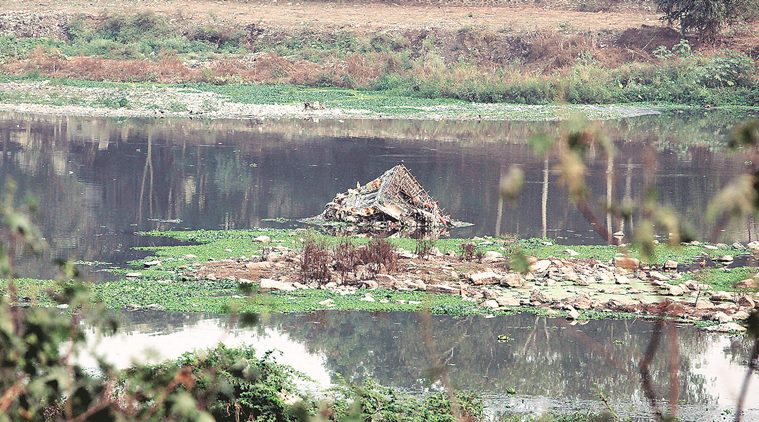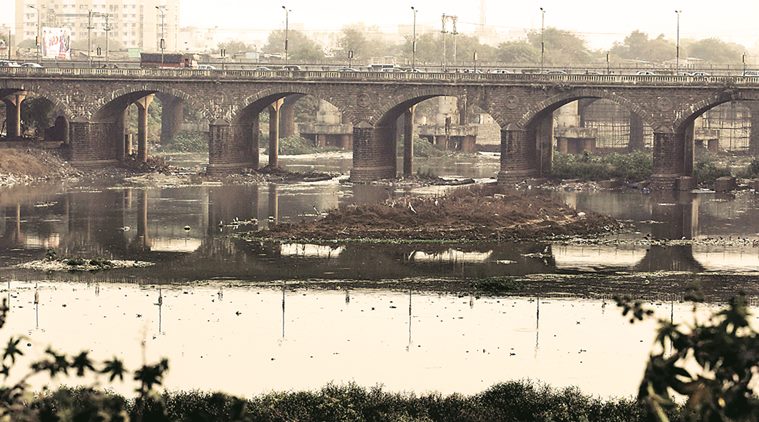- India
- International
Dying Rivers of Pune Part I: Untreated sewage, garbage define Mula, Mutha
In a three-part series, Pune Newsline tracks the city’s water bodies, which have been deteriorating due to public and civic apathy.
 n Mutha River: Builders and local residents have not only turned the river into a dumping site for construction material, they have also encroached on the river banks
n Mutha River: Builders and local residents have not only turned the river into a dumping site for construction material, they have also encroached on the river banks
Though the names of the two rivers, Mula and Mutha, are synonymous with the identity of Pune, they can hardly be termed as ‘rivers’ any more, due to the senseless damage caused to them over the past few decades.
Mutha River: Starting from its source, Vegre village, till it reaches the Bay of Bengal, Mutha travels approximately 1,100 to 1,200 kilometres. In and around the city, Mutha stretches from Vegre to Khadakwasla, covering 45 kms. From Khadakwasla to Sangam Bridge, it stretches for about 15 kms. At Sangam Bridge, the river becomes Mula-Mutha and stretches upto Hadapsar for nearly 15 kms. And from Hadapsar, till the confluence of Bhima at Ranjangaon Sandas at Ahmednagar district, it stretches for 60 kms.
 n Mula-Mutha rivers: Several studies have been conducted to gauge the level of pollution in these rivers, its impact on biological diversity, agriculture and human health
n Mula-Mutha rivers: Several studies have been conducted to gauge the level of pollution in these rivers, its impact on biological diversity, agriculture and human health
Ruing the current status of Mutha, Shailaja Deshpande, director of Jeevitnadi-Living River Foundation, said, “It’s not a river, but a sewer. Mutha is dead. The PMC may claim anything but the amount of untreated sewage entering the river directly is too much, it’s beyond the capacity of Mutha to cleanse itself. Untreated toxins such as domestic detergents and other cleaning products, which enter the river, make the water more harmful, killing the fauna and flora of the river.”
Builders and local residents have not only turned the river into a dumping site for construction material, they have also encroached on the river banks, she said. The channelisation of the river has choked Mutha’s springs and streams. “The total disconnect between Pune residents and refusal to accept responsibility has worsened the problem,” she said. Deshpande cautioned that Mutha is an unsafe river, saying Khadakwasla, the biggest reservoir among the four dams, is only a few kms from Mutha. A cloudburst or heavy rainfall in catchment areas in any of the dams is likely to trigger a release of water, she said. “The PMC has not demarcated flood lines – blue line and red line. “Most of the low-lying areas of Pune city, on the banks of Mutha, either lie along the blue line or red line, making them more unsafe,” she added.
Mula River: Mula river originates at Mula-Devghar, approximately 65 km west of Pune. Dammed at Mulshi during the early 1920s, it flows further downstream and enters the Pune urban area near Balewadi. It flows down along the edge of Wakad to Aundh, Bopodi (where Pawana river joins her), through Khadki, Vishrantwadi, Wakdewadi to Sangam, where it joins Mutha to form Mula-Mutha river. From Sangam, it lows downstream to Bund Garden, Yerawada, through Koregaon Park, Kalyani Nagar and Mundhwa. It exits Pune urban area near Kharadi IT Park.

 n Mula River: Polluted mostly by domestic waste — as evident from algael blooms and growth of water hyacinth — as well as garbage and construction waste dumped in the river
n Mula River: Polluted mostly by domestic waste — as evident from algael blooms and growth of water hyacinth — as well as garbage and construction waste dumped in the river
Speaking on the current situation of the river, Mukul Mahabaleshwarkar, an environmental scientist from INTACH’s Pune Chapter, said studies have been conducted by many scientists to gauge the pollution levels of Mula, Mutha and Mula-Mutha rivers, as well as its impact on biological diversity, agriculture and human health.
It has been observed that the stretch of Mula river, till it meets Pavana river, has been polluted mostly by domestic waste, i.e sewage, as evident from algael blooms and high growth of water hyacinth, as well as garbage dumped in the river and construction waste in some parts.
“… Agriculture run-offs also get mixed with Mula river water in upstream areas. After the confluence with Pawana river, some industrial effluents also get added to this river. Mutha river adds a combination of domestic and industrial waste to the Mula-Mutha river system. Lower dissolved oxygen levels, as low as 0.4 mg/l, occurrence of heavy metals, BOD and COD levels, etc are indicators of the fact that Mula-Mutha rivers are drying up,” he said.
Mahabaleshwarkar said dumping construction debris is responsible for obstructing the flow of water. The diversity of native fish species, in both Mula and Mutha rivers, has gone down significantly due to pollution and loss of habitat.
Click here to join Express Pune WhatsApp channel and get a curated list of our stories
Apr 25: Latest News
- 017 hours ago
- 0216 hours ago
- 036 hours ago
- 0416 hours ago
- 057 hours ago








































